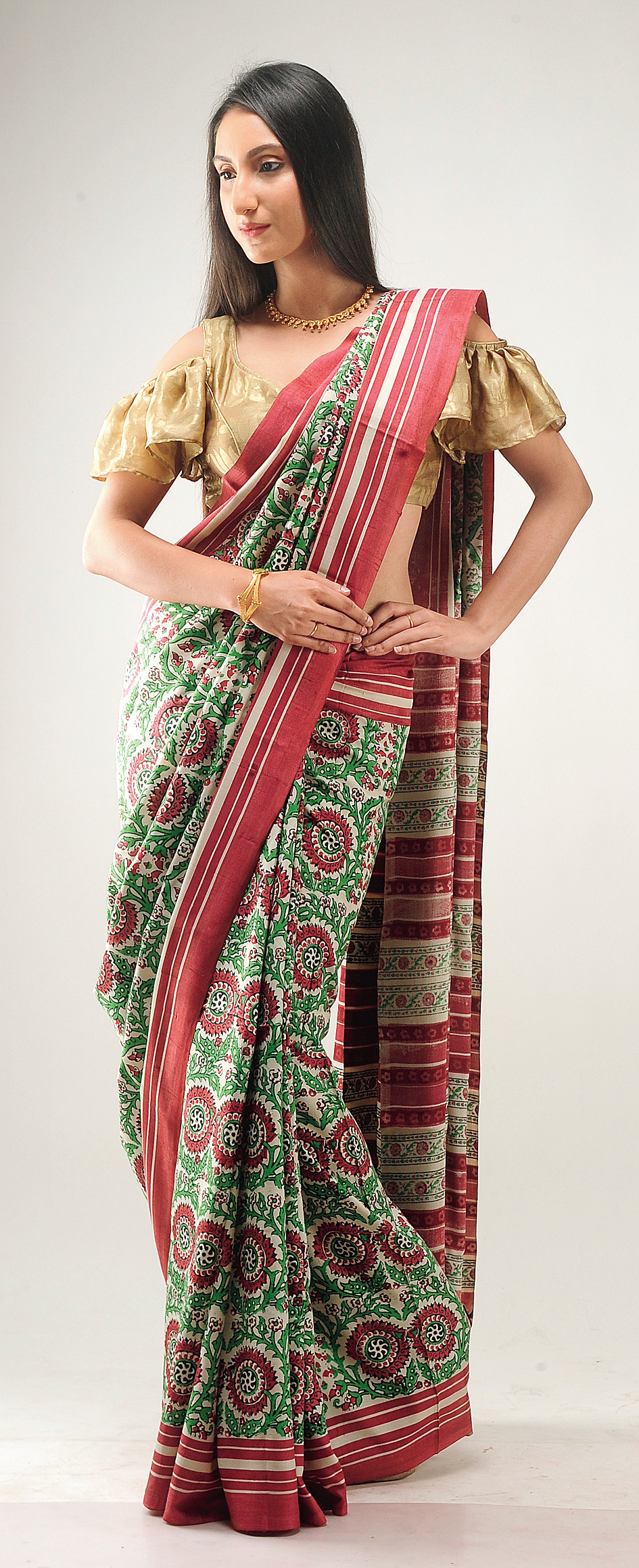
Dashami: Off-white katan silk Benarasi with broad red and black Ganga-Jamuna checked border and black and red flowers on the body. Subhendu Chaki

Nabami: Master-weaver showstopper from Benares in orange/pink shot colour katan silk with classical dancing figures in zari in pairs all over the body, offset by a contrasting magenta zari border and pallu. Subhendu Chaki

Shasthi: The pandal visits can begin with a tussar print with floral alpana style block-print in maroon and green. Subhendu Chaki
-
Models: Sourasrita Bhattacharjee, Paramita Dasgupta and Sanghasree Roy
-
Hair and make-up: Saikat Nandy
-
Styling: Proloy Dasgupta
-
Creative direction: Nick Rampal
-
Photographer: Subhendu Chaki
Jewellery courtesy: Senco Gold & Diamonds
Jewellery courtesy: Senco Gold & Diamonds

Ashtami: Morning. Offer the anjali to the goddess in this broad striped-border Tangail with matching red and orange block-printed floral design. Subhendu Chaki

Ashtami: Evening. Specially woven tussar with multi-coloured full body work and contrasting pallu with “kasuti” buti. Subhendu Chaki
However much it has evolved – and it has – the saree, at its core, remains traditional. As the Puja days culminate in a burst of colours and designs and fabrics, one can also see how this most elegant, unstitched piece of cloth retains its very features that have been experimented with, colours, designs and fabrics, even as it has recreated itself by taking on new features. (There is a lot to be learned from the sari.)
Long before the recent, intensive experimentation with the saree, especially the handloom saree, began, a landmark Calcutta store had started it. Established on August 15, 1974, Ananda aimed at reviving handloom saris of Bengal, with an emphasis on novelty in designs, colours, and most important, on quality. Master weavers were engaged in Phulia, the seat of the Bengali saree, and in Dhaniakhali, to recreate old styles in new fabrics. The weavers were provided with new yarns and designs. As they worked at their looms, the trademark “Ananda Tangail” was born.
Soon after came the block- and screen-printed silks. “Kalka”, “Scroll” and “Bobby Dots” meant something special for the women of Calcutta, as did the hand-embroidered Ananda panjabis and dhotis for the gentlemen.
From the beginning, Ananda has worked closely with the weaver families of Benares. Ananda’s designers have worked with them on each aspect of saree-making: patterns, colour palettes, thread counts, yarns and zari.
Such close collaboration with the master weavers over decades had resulted in “gems” that the boutique is proud of: 'keri', 'bael buti', 'kinkhaab', 'konia', 'jamdaani', 'shikargah', 'leheriya' or 'kadhwa'. Ananda boasts of these styles in a range of fabrics, such as katan silk, crepe silk, tussar, kora and cotton.
Master weavers from other parts of the country, such as Andhra Pradesh and Tamil Nadu, have also worked with Ananda to create masterpieces: cottons, silks, crepe de chines, Kanjivarams, Ikkats.
Each saree is a story, into which have been woven the work, the lives and the imagination of generations of a master weaver’s family.
Here, the models are wearing six of Ananda’s designs. We thought of suggesting to the readers a saree code for the Pujas.










